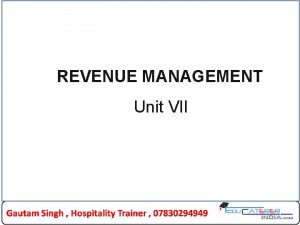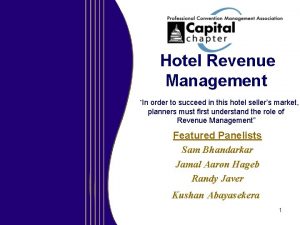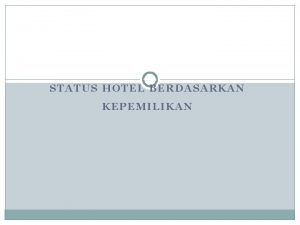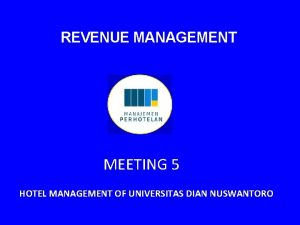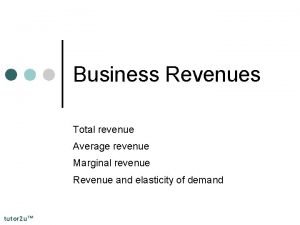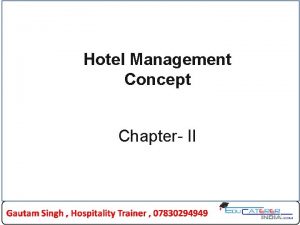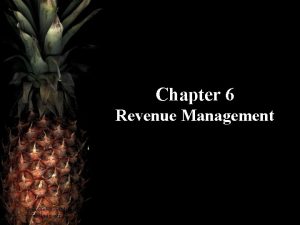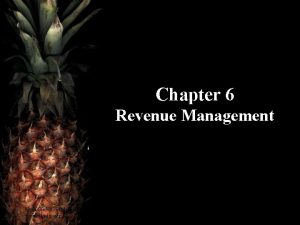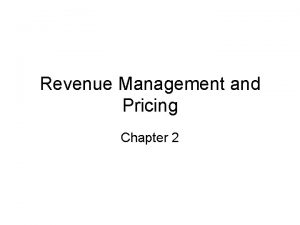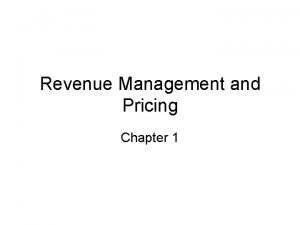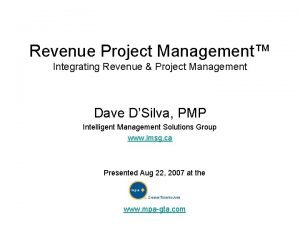Revenue Management Revenue management in the Hotel and


























- Slides: 26

Revenue Management Revenue management in the Hotel and Leisure Industry Martin Hermsen Senior Manager Strategy Practice, Deloitte Consulting Telephone: 31 -629 -068. 604 Copyright Deloitte Consulting © 2001 - Proprietary and Confidential January, 2001

Table Of Content § Introduction § Industry Background § Customer Relationship Management and the Internet § Yield Management Definition § Implementing a Yield Management System Doc: YM-RSM 2001 -A - 2 - Copyright Deloitte Consulting © 2001 - Proprietary and Confidential

The eight core concepts of revenue management 1. Focus on price rather than costs when balancing supply and demand 2. Replace cost based pricing with market based pricing 3. Sell to segmented micro markets, not to mass markets 4. Save your products for your most valuable customers 5. Make decisions based on knowledge 6. Exploit each products value cycle 7. Continually reevaluate your revenue opportunities 8. Revenue management should be integrated into the strategy, process, systems- and mind-set from an 3 - Doc: YM-RSM 2001 -A Copyright Deloitte Consulting © 2001 - Proprietary and Confidential

Industry Background The Leisure value chain is changing: vertical integration, everybody wants to dominate Hotels/Clubs Tour operator Credit card co. Airlines Internet Shops / DM / Internet Core business Shops / DM / Internet Call Centres Volume buying Call Centres Others. . . Countries CRS Companies Marketing Via Alliances Retail Via Alliances Core Business Bus, Train Via alliances Theme parcs Banks Core business Reservation Core Business Clubs / Hotel Payment In Hotel or via alliances Via alliances package deals Package offerings Theme parcs To-site Transport Hotel buses via alliances Via alliances Car rental co. ’s Overnight stay Present in Hotel Packages Conference centres Entertainment Moderate presence Strong presence Core business At-site Transport Source: Deloitte Research 1 Q 2000. Doc: YM-RSM 2001 -A Facilities (conferences etc. ) - 4 - Copyright Deloitte Consulting © 2001 - Proprietary and Confidential

Industry Background The Revenue drivers for the hotel businesses based on both the room revenues AND various related revenue sources Competitive Intensity Market Conditions Macro-economic factors Socio-Political factors Number of owned / leased hotels Ave. fee per room % in 5* brand Ave. room rate % in 4* brand Occupancy rate % in 3* brand Number of rooms available CRS Revenue Total Room Revenue Number of rooms sold Ave. Spend Other Services Ave. no. of persons per room In-House Services Revenue Number of In-houseguests In-House F&B Revenue Ave F&B Spend In-house guest Number of Out house customers Ave F&B Spend Out-house cust. # of Hotels with special facilities # of special Events Usage rate of facilities Average spend Per person Average # of Persons per event Limited Intervention Doc: YM-RSM 2001 -A Average spend per event Out-House F&B Revenue Average spend per event Effective Scope For Intervention - 5 - Copyright Deloitte Consulting © 2001 - Proprietary and Confidential REVENUES

Industry Background Internet gives the consumer multiple entry points, leading to different economics per reservation Hotel Group Market Call to Travel Agent Travel Agency http: //www. thomascook. com $6 to $8 Global Distribution System $3 to $5 GUESTS http: //www. travelocity. com Switch Company http: //www. travelwiz. com Call to CRS http: //hilton. com $2 to $3 Central Reservation System Call to Property http: //holidayinn. com Entry point Margin paid Travel agent (Package) 22% Travel agent 12%+$4. 36 3 rd party site 5%+$4. 36 Hotelgroup. com 0 Hotel Properties Booking a hotel room through the internet Booking a hotel room via traditional reservation structure Source: Deloitte Research Doc: YM-RSM 2001 -A - 6 - Copyright Deloitte Consulting © 2001 - Proprietary and Confidential

Industry Background Industry Trends § The travel industry is consolidating rapidly in Mature Markets (Europe, US) § Consumers increasingly buy their travel on the Internet. § Consumers become more “Trip Oriented” § The most important revenue driver for Hotel Companies is Rev. Par – REVPAR, revenue per room = occupancy * average room rate § Hotel chain’s will sell directly to end-consumers on the Internet or via call centers to: – Save the cost of distribution; – Create an opportunity to enhance revenue by selling the exact right product for the best price, at the best moment in a specific market segment as a function from the demand. Doc: YM-RSM 2001 -A - 7 - Copyright Deloitte Consulting © 2001 - Proprietary and Confidential

Table Of Content § Introduction § Industry Background § Customer Relationship Management and the Internet § Yield Management Definition § Implementing a Yield Management System Doc: YM-RSM 2001 -A - 8 - Copyright Deloitte Consulting © 2001 - Proprietary and Confidential

Customer Relationship Management and the Internet CRM Strategy sets direction for how the organization invests in customer relationships… Customer Segments Life Time Value Targeted Segments Customer Interaction Touch Points Value Proposition Required CRM Capabilities Customer Life Cycle Target Acquire Retain Investments Priorities Doc: YM-RSM 2001 -A - 9 - Copyright Deloitte Consulting © 2001 - Proprietary and Confidential Expand

Customer Relationship Management and the Internet Customers today have a choice of a variety of interaction channels Customer Management Processes Customer Interaction Channels Marketing Selling Servicing Broadcast Media Mail Field Personnel Agents/Distributors Call Center Retail Internet Back Office Processes and Systems Doc: YM-RSM 2001 -A - 10 - Copyright Deloitte Consulting © 2001 - Proprietary and Confidential

Customer Relationship Management and the Internet Today’s technology enables companies to be true consumer centric (stage 2), however most companies have a long way to go… Mindset Operations Strategy Our clients are typically in one of these three general evolutionary stages Stage 0: Fragmented Stage 1: Optimized Silos Stage 2: Integrated Enterprise Customer Segmentation Macro Factors Observable Qualities Actionable Behaviors Customer Worth Revenue-based Profit-based Life Time Value-based Value Proposition Generalized Mass-customized Unique Competition and Market Dynamics Reactive Proactive Predictive Touch Point /Channel Structure “One Size Fits All” Targeted Adaptive Integration Structure Isolated Touch Points Functional Integration Seamless Enterprise Systems/Technology Point Solutions Tactical Strategic Processes Policies & Procedures Flexible Enabling Limited Capture Data Silos Centralized Customer-aware Customer-intimate Customer-collaborative Task-oriented Team-oriented Relationship-oriented Product/Cost-centered Mixed Message Loyalty-centered Information/Data Organization People Leadership Majority of current companies Doc: YM-RSM 2001 -A - 11 - Copyright Deloitte Consulting © 2001 - Proprietary and Confidential

Customer Relationship Management and the Internet …ultimately enabling real time reaction to dynamic customer behavior, market forces and demand fluctuation TECHNOLOGY allows data to be recorded, stored, and mined for insights The ORGANIZATION responds faster to changing conditions and reinvents itself to meet new customer needs in zero time The organization SEGMENTS its customers and TARGETS its offerings (product, service, distribution, message) efficiently and effectively to meet changing customer needs. The organization LEARNS from every interaction with each customer and captures information from marketing campaigns/customer touch points. CUSTOMER behavior changes over time as a relationship with the enterprise is developed Ultimately, the results of achieving this vision will be real time consumer demand tracking, dynamic pricing, increased wallet share, increased return on campaign spending, greater profitability per customer and greater shareholder value. Doc: YM-RSM 2001 -A - 12 - Copyright Deloitte Consulting © 2001 - Proprietary and Confidential

Table Of Content § Introduction § Industry Background § Customer Relationship Management and the Internet § Yield Management Definition § Implementing a Yield Management System § Appendix – Example of an Approach to Analyze and Design a Yield Management System Doc: YM-RSM 2001 -A - 13 - Copyright Deloitte Consulting © 2001 - Proprietary and Confidential

Yield Management Definition A definition of Yield Management § Yield management is the practice of maximising profits from the sale of perishable assets, such as hotel rooms / airline seats, by controlling price and inventory and differentiating product and service. § Yield management is based on: – The differentiation of tariffs/rates/margin – Segmentation of consumers, understanding of consumer lifetime value and understanding specific consumer needs – Differentiation of products and services – Statistical modelling and forecasting demand § By seizing control of the sold volume at each price level, Yield Management permits a significant augmentation of revenue. Doc: YM-RSM 2001 -A - 14 - Copyright Deloitte Consulting © 2001 - Proprietary and Confidential

Yield Management Definition Yield Management, The Concept Forecast of occupancy: With increasing accuracy when time comes closer 100 90 80 60 Budget 50 40 Forecast 30 Actual 20 10 0 Leadtime (days) 60 45 30 15 Moment in time where occupancy is low: • What does the forecast say? • What is the total revenue, actual sold, of the hotel for that day? • What should be the price of the room? • Who is the customer that calls during the time of the red arrow? Doc: YM-RSM 2001 -A - 15 - Copyright Deloitte Consulting © 2001 - Proprietary and Confidential 0 Occupancy 70

Yield Management Definition Yield Management Drivers § The Time Focus, (A hotel room that is not sold for a certain night is lost forever). – The closer the moment on the timescale when a hotel room is still empty the larger the probability that it stays empty and will not create revenue. – A Hotel chain will lower it’s selling price of a room when at a certain moment it’s forecast will tell him that, with a certain probability, it will stay empty. § The Customer Focus – How does Yield management interact with Customer Loyalty? – Loyalty programs are designed to lock-in consumers to the product. The frequent customer therefore, could based on his profile, deserve a different treatment and price then a less frequent customer. – Loyal customers expect a consistent discounted price all year long. Yield management policies should therefore have special long-term strategies for loyal customers enforcing repeat visits. Doc: YM-RSM 2001 -A - 16 - Copyright Deloitte Consulting © 2001 - Proprietary and Confidential

Yield Management Definition Example of yield optimization decisions analysis Occupancy 1. Actual reservations are below the Rate % reservation profile, 60 days before roomnight. In this case the Hotel might accept bookings with some discounts, however we are still relatively far from due date, alternative marketing strategies could be pursued. Optimization Decision Areas 2. The actual sales resulted in an 4 70 Reservation Profile 3. The demand curve went down, 2 apparently there where some cancellations and the due date comes closer. The hotel will use aggressive marketing strategies and discount rooms to reach target occupancy. 3 1 Reservations Leadtime (days) Doc: YM-RSM 2001 -A occupancy rate above the reservation profile. The hotel will sell rooms only at full rates, to maximise profits, assuming that the demand curve will continue. 4. The demand curve really picks up. The 45 30 15 0 - 17 - 70% target occupancy is passed 8 days before due date. The hotel goes back to full rates. Copyright Deloitte Consulting © 2001 - Proprietary and Confidential

Yield Management Definition Revenue gains as a result from yield management increase when we cluster destination area’s and enable consolidation of demand Margin improvement Shift of special contracts 8% Up-sell Capacity transfer Optimal group placement 4% Overbooking Group quote Length of stay control Discount allocation Property levers Doc: YM-RSM 2001 -A Cluster levers - 18 - Copyright Deloitte Consulting © 2001 - Proprietary and Confidential

Yield Management Definition The results of yield management are § A larger margin of price variation § Product differentiation in order to justify the price to the customer – A high priced product should be presented differently in terms of packaging, conditions of the sale, and accompanying privileges than it’s reduced-priced counterparts. § Dynamic control in “real time” of the volume sold at each price level § Definition of these different prices and volumes requires numerous recurrent and complex calculations – Which makes the implementation of a decision-making tool necessary. Doc: YM-RSM 2001 -A - 19 - Copyright Deloitte Consulting © 2001 - Proprietary and Confidential

Yield Management Definition The impact or the internet and the rise of dynamic pricing § At the technical level, there is a distinction between traditional revenue management and dynamic pricing – Traditional revenue management models avoid developing an explicit relationship for demand as a function of price – Demand is lumped into product buckets, and forecasts may or may not use price as an input – Dynamic pricing models might be categorized as those models that assume a functional relationship between demand price § The internet makes it possible to design web sites that experiment with the market in an attempt to elicit information for demand curve estimation § Dynamic pricing may become synonymous with managing and tracking demand in response to posted prices interactively § The internet provides the opportunity to gain more data on the customer at the point of sale: buying behavior: loyalty profile, price elasticity § Dynamic pricing may eventually become synonymous with increasingly refined methods of market segmentation and the ability to capture transaction information that will allow for more detailed pricing Source: E. Andrew Boyd, PROS. Doc: YM-RSM 2001 -A - 20 - Copyright Deloitte Consulting © 2001 - Proprietary and Confidential

Table Of Content § Introduction § Industry Background § Customer Relationship Management and the Internet § Yield Management Definition § Implementing a Yield Management System Doc: YM-RSM 2001 -A - 21 - Copyright Deloitte Consulting © 2001 - Proprietary and Confidential

Implementing a Yield Management System Yield Management process scope covers different functions Functional Scope of Revenue Management : from market segmentation through booking management Market Segmentation The classification and targeting of distinct categories of demand based on customer values, behaviors, usage patterns, price and service sensitivity, cost/profitability to serve, etc. Offer Management The creation of products, the definition of target price and service levels, and the negotiation of contracts with suppliers to provide those products at a certain price. Demand Forecasting Availability Management Booking Management Doc: YM-RSM 2001 -A The projection of future demand based on historical trends, cycles, seasonal patterns, and current market conditions or events. The forecasting and allocation of available capacity to various customers or customer/product segments based on their revenue contributions relative to the “opportunity cost” of selling that capacity. The “scripting” and execution of the day-to-day booking process through which bookings are either accepted or rejected, routed, and specific price/service commitments are made to customers. - 22 - Copyright Deloitte Consulting © 2001 - Proprietary and Confidential

Implementing a Yield Management System These processes also span different time horizons Example Revenue Management Time Horizons* Market Segmentation Offer Management Demand Forecasting Availability Management Strategic 1 year plus Tactical Operational 1 to 12 months 3 to 30 days Real-time 0 to 3 days Booking Management * These timeframes are typical of the travel and leisure industry. Doc: YM-RSM 2001 -A - 23 - Copyright Deloitte Consulting © 2001 - Proprietary and Confidential

Implementing a Yield Management System The combination of these two dimensions provides a basis for defining a high-level business process map for Yield Management High-Level Process Map Hospitality Market Segmentation Offer Management Demand Forecasting Capacity / Availability Management Booking Management • Analyse & define strategic market segments • Define and analyse customer segments • Track costs by segment • Define market positioning and overall pricing policy • Create global advertising plan • Create seasonal pricing calendars by country • Define price tiers • Determine segment “strategic values” • Establish targeted promotional pricing programs • Develop macro-economic forecasts of demand • Revise and maintain forecasting models and parameters • Develop initial time-series forecasts • Project impact of • Track booking/cancellation promotions curves • Track booking/cancellation • Adjust forecasts curves • Adjust forecasts • Plan long-term park/ hotel development • Select key TO partners • Determine oversale cost • Negotiate TO and other dedicated allocations • Arrange for transport. capacity • Negotiate group and convention sales • Monitor TO realization • Determine individual availabilities • Proactively manage overbooking • Walk-in response • Develop reservations scripts and protocols • Revise reservation agent scripts and up-sell/crosssell approaches • Revise reservation agent scripts • Sell/Up-sell/Cross-sell • Monitor conversion rate Strategic Doc: YM-RSM 2001 -A Tactical - 24 - Operational Real-time Copyright Deloitte Consulting © 2001 - Proprietary and Confidential

Implementing a Yield Management System To define the Decision Support Requirements we need to understand the opportunity for analytic tools to support these processes High-Level Hospitality RM Tool-Process Overlay Market Segmentation Offer Management Demand Forecasting Capacity Management Booking Management • Analyze & define strategic market segments • Track costs by segment • Define market positioning and overall pricing policy • Create. Strategic global advertising plan • Create seasonal pricing • Establish targeted calendars by country Pricepromotional pricing • Define price tiers programs Elasticity Model • Determine segment “strategic values” • • Revise and maintain forecasting models and parameters • Develop initial time-series forecasts • Project impact of • Track booking/cancellation promotions curves Forecasting • Track booking/cancellation • Adjust forecasts curves System • Adjust forecasts • Plan long-term park/ hotel development • Select key TO partners • Determine oversale cost • Negotiate TO and other TO dedicated allocations Allocation • Arrange for transport. capacity • Negotiate group and Group/Conv. convention sales Acceptance • Monitor TO realization • Determine individual Tool availabilities • Determine individual availabilities Availability • Proactively manage Optimizer overbooking • Walk-in response • Develop reservations scripts and protocols • Revise reservation agent scripts and up-sell/crosssell approaches • Revise reservation agent • Sell/Up-sell/Cross-sell • Monitor conversion rate Value Develop Audit macro-economic forecasts of demand Tool Strategic Doc: YM-RSM 2001 -A Tool Tactical - 25 - Up-sell /Cross-sell scripts • Sell/Up-sell/Cross-sell • Monitor conversion rate Scripting Tools Operational Real-time Copyright Deloitte Consulting © 2001 - Proprietary and Confidential

Implementing a Yield Management System Implementing YM is not a one time event. It is a process of continuous learning and refinement Continuous learning and refinement YM Operational Framework for Continuous revenue optimization 1. Data Collection. Identify and collect required data on demand on hotel level 2. Analyse Demand. Identify competitors and sources of demand, hotel’s strengths and weaknesses, predict demand booking patterns 3. Market Segmentation. Identify markets, segment market (demographic, psychographic, geographic) 4. Determine optimal guest mix. Define booking classes 5. Analyse trade-offs. Extensive calculations of monetary leakages, avoid displacing higher spending guests 6. Establish capacity levels (Capacity to meet demand of market segments) 7. Yield management pilot/change (City, Regions, Destinations) 8. Evaluate pilot/change. (Customer reorientation, operational evaluation) 9. Improve Yield Management based on latest learning's Doc: YM-RSM 2001 -A - 26 - Copyright Deloitte Consulting © 2001 - Proprietary and Confidential
 Revenue management formulas
Revenue management formulas Hotel revenue management glossary
Hotel revenue management glossary Bentuk kepemilikan bisnis hotel
Bentuk kepemilikan bisnis hotel Hotel database sql queries
Hotel database sql queries Hyper-themed hotel: fantasyland hotel, canada
Hyper-themed hotel: fantasyland hotel, canada Cara menghitung revpar hotel
Cara menghitung revpar hotel Non revenue generating department
Non revenue generating department Total revenue
Total revenue Hát kết hợp bộ gõ cơ thể
Hát kết hợp bộ gõ cơ thể Ng-html
Ng-html Bổ thể
Bổ thể Tỉ lệ cơ thể trẻ em
Tỉ lệ cơ thể trẻ em Chó sói
Chó sói Tư thế worm breton
Tư thế worm breton Hát lên người ơi alleluia
Hát lên người ơi alleluia Các môn thể thao bắt đầu bằng từ đua
Các môn thể thao bắt đầu bằng từ đua Thế nào là hệ số cao nhất
Thế nào là hệ số cao nhất Các châu lục và đại dương trên thế giới
Các châu lục và đại dương trên thế giới Công thức tiính động năng
Công thức tiính động năng Trời xanh đây là của chúng ta thể thơ
Trời xanh đây là của chúng ta thể thơ Mật thư anh em như thể tay chân
Mật thư anh em như thể tay chân 101012 bằng
101012 bằng độ dài liên kết
độ dài liên kết Các châu lục và đại dương trên thế giới
Các châu lục và đại dương trên thế giới Thơ thất ngôn tứ tuyệt đường luật
Thơ thất ngôn tứ tuyệt đường luật Quá trình desamine hóa có thể tạo ra
Quá trình desamine hóa có thể tạo ra Một số thể thơ truyền thống
Một số thể thơ truyền thống
